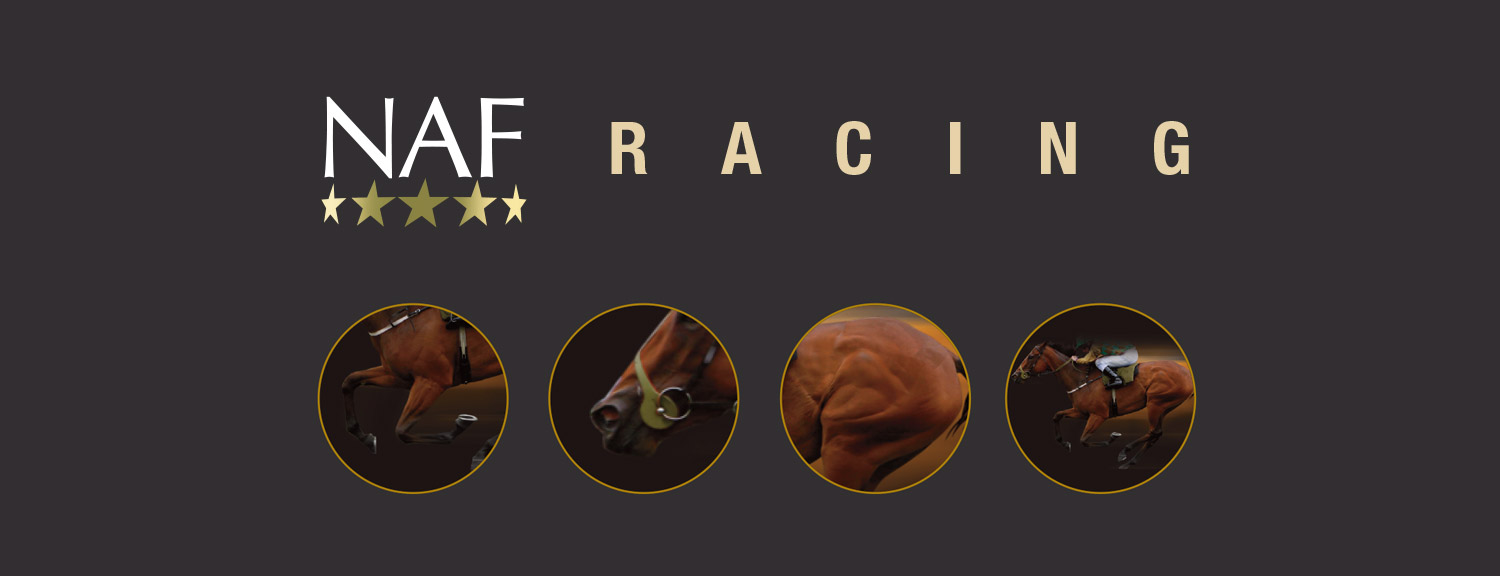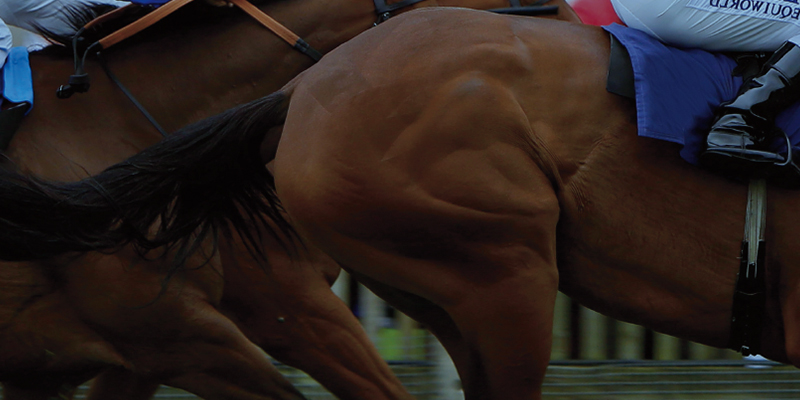



Horses, and particularly racehorses, have a high muscle mass to size ratio, which is what makes them such natural and effective athletes. Ensuring that muscle mass reaches full potential and maintains strength and integrity at times of greatest need, is one of the principles pillars of successful conditioning and training.
So ensuring that muscle health keeps pace with your training schedule for that horse, is crucial. We need to ensure that horses reach the track primed and ready for the next race, but also that they recover effectively to avoid injury and get back to training in good time. The line between maximising muscle health and overdoing it can be a fine one, so we need to tread it carefully.
The racehorse’s muscles make up over 60% of his bodyweight and consists of over 700 skeletal muscles.
There is no bony attachment of the forelimb to the rest of the horse; instead the connection is muscular, so allowing for greater freedom of movement.
Overtraining – putting the strain in train.
Overtraining is a recognised syndrome in both human and equine athletes, with extensive research in human athletes. A sound body of evidence in horses has clinically recognised the condition, often called 'staleness' or 'sourness' by trainers, as long ago as the 1960s. Overtraining has been defined as an imbalance between training and recovery resulting in poor performance, which may be seen as both physical and behavioural changes. Once overtraining occurs an athlete, either human or equine, will reach a plateau so that no matter how hard they train they cannot improve. The opposite is usually the case, they’re working harder but going slower.
One issue we have is that the signs and symptoms are not consistent, and of course our equine charges can’t tell us how they’re feeling. So we need to be vigilant for signs of overtraining, an overview of which are shown overleaf in Table 1.
After the principle sign of reduced performance, the most important and consistently noted of the clinical signs is behavioural changes. Research suggests that being aware of behavioural changes is the best early indicator that a young horse is not coping with his current level of training, or that an experienced racehorse is at risk of overtraining. In human athletes, depression will be an early sign. In horses behavioural signs are most usually irritability and an unwillingness to complete training, for example, barging, not wanting to go in the school or on the horse-walker, or persistant head tossing.
| Principle sign Seen in all overtrained horses |
Clinical signs May have one or more of these |
Sub-clinical signs May have any or none of these |
|---|---|---|
| Poor performance | Behavioural changes | Elevated muscle enzymes, aspartate transaminase (AST) and creatine kinase (CK) |
| Reduced earnings / results on previous season. | Elevated leukocytes with reduced eosinophils | |
| Weight loss | Reduction in red blood pack cell volume (PCV) | |
| Poor appetite | Elevated liver enzyme, gamma-glutamyltransferase (GGT) | |
| Muscle tremor | Increased lactate concentrations | |
| Sweating, Diarrhoea, Incoordination, Injury, Lost days training, Premature retirement | Increased cortisol levels |
Overtraining – the causes
The simplest cause of overtraining is that the horse is not capable of coping with the level of work required of him or her. In young horses, particularly, their physical frame may not yet be supportive enough of the work required. Maximising muscle growth and strength will help to ensure the young horse can cope with all that is asked of them. The training regime also needs to be examined, as periods of intense training without sufficient time to recover will result in overtraining, as will a monotonous training regime with little or no variety.
Powering with Nutritional Tools
If we consider those hidden, internal, signs shown in Table 1 we can see that muscle health, muscle integrity, fitness and the ability to exercise at the required level is NOT just about building muscles – it’s far more complex than that. So we need a complex nutritional strategy to support all those areas that are likely to show stress through training. This will allow both the young developing horse, and the established performance horse, to grow, develop and perform to the best of their ability.
Lysine
The elevated AST and CK levels are signs of micro trauma within the muscles, showing muscle recovery is not keeping pace with the challenge of training. This may be caused, in part, as the amino acids within the diet are used up faster than they are being supplied. Therefore the provision of Lysine, the most important, or ‘first limiting’, amino acid to equine diets, ensures muscle growth and repair can maintain a healthy muscle structure, working as part of day to day training.
Zinc
Zinc is an important nutrient for muscle health, with half of the body’s total zinc being held in muscles. Zinc is a key constituent of the enzyme Superoxide dismustase (SOD), a deficiency of which is associated with lack of muscle mass and muscle atrophy.
Magnesium
Magnesium works on nerve endings in muscles to support relaxed, healthy muscles. Within the UK magnesium can be naturally low in soil, particularly in areas of high rainfall. Low magnesium may be seen as tight muscles and muscle spasm.
Immune Challenge
Altered levels of the white blood cells, leukocytes and eosinophils, shows the immune challenge associated with overtraining. This is seen in athletes, both human and equine, by suppressed immune function post-exercise leaving them prone to picking up illnesses more easily, and reducing their ability to repair any trauma within the system.
Adaptogens are defined as natural products that help the system cope with physiological stress. Adaptogens achieve this is by supporting the immune system, and in athletes this is seen as reduced fatigue, better exercise tolerance and shorter periods of recovery. Long recognised in traditional herbal medicine, the role of adaptogens is increasingly recognised in modern clinical nutrition.
The adaptogen herbs Omicha berries and Ginkgo, are recommended to help the horse’s system cope with the physiological stresses of training, important both to young horses where their systems are adapting to their work, but also in elite athletes to keep them at the top of their game.
Oxidative Stress
The liver enzyme GGT is a useful biomarker of physiological stress within the system and, in humans, is being increasingly recognised as a useful early indicator of many disease conditions. As a liver enzyme it is also an early indicator of oxidative stress, a build-up of which is seen when the body’s antioxidant defences can’t keep up with exercise induced production of free radical toxins. The effect of oxidative stress in training and performance horses is seen in issues such as poor performance, injury, minor diseases and lost training days.
Therefore, it is recommended to supplement with natural antioxidants including Rosehip shells and Milk Thistle Seeds with the antioxidant Vitamin E to ensure oxidative capacity is maintained within the system. These antioxidant defences allow the horse to perform maximally without risk of a chronic build-up of physiological stress.
Hormones
A number of hormonal changes may be seen as a response to training, the most easily noted is an increase in cortisol levels. Cortisol, often called ‘the stress hormone’ is mobilised as part of the body’s response to stress, both physiological and psychological. While anabolic hormones, such as insulin and testosterone, are important growth factors, cortisol is a catabolic hormone and works in the opposite way. For muscle health an excess of cortisol prevents protein synthesis and can actually break down muscle cells, resulting in muscle atrophy.
The adaptogenic herbs discussed earlier are also important here, as adaptogens appear to lower cortisol levels and improve the athlete’s emotional response to training, which can be just as relevant as the physical response.
Conclusion
We can see that as training increases the specific nutritional demands on the system also increase. Failure to keep pace with this increased demand will result in overtraining, a chronic fatigue syndrome which will take weeks, or even months, for a full recovery. While overtraining syndrome is the acute stage, and hopefully we don’t get that far, the sub-clinical signs show us what the system is working against in day to day training, particularly as horses move up the groups and training intensity increases.
Gradually increasing training is a great way of increasing muscle mass and fitness, aerobic capacity and performance, but only if we empower the horse with the nutritional tools to cope – and we now recognise that ‘tool box’ is large and complex. Historically we’ve thought of nutrition for muscle health to be all about amino acids and protein synthesis, but there is so much more to it than just that. If we want our racehorses to win and keep winning at the highest levels, then we need to provide them with specific nutritional tools that address all areas.
Selected References
McGowan CA & Whitworth DJ (2008) Overtraining syndrome in horses. Comparative Exercise Physiology. May 2008, p.57-65
Jang HJ et al (2017) Analysis of metabolomic patterns in thoroughbreds before and after exercise. Asian-Australisian Journal of Animal Science. Nov;30(11):1633-1642

In nearly every species muscle power is required in order to move, and in horses this means much more muscle power than we humans can muster. Not only in terms of size, which befits their larger bodyweight, but also number. For example, horses have sixteen muscles in each ear, allowing them to move their ears around 180 degrees, compared to just six in the human ear. Why you might ask? Simple – as prey animals they need to be able to hear danger coming from all directions and take flight, quickly and efficiently.
It is this flight mechanism that racehorses use so effectively on the track. Horses can gallop for extended periods of time at an average speed of around 30mph. How do they compare to us mere mortals? Consider the legendary Secretariat, who set the record for the Kentucky Derby racing at 38mph, compared to the 1500m world record for athletes which was set at less than half that speed. When we look at sprinting, the Guinness Book of Records reports the fastest horse recorded as ‘Winning Brew’ who reached almost 44mph over 400m in 2008, compared to the fastest human athlete, Usain Bolt, at 23.4mph over 100m.
The evidence is clear - whether we are looking for endurance or sprinting, the racehorse is a supreme athlete, and muscle power is at the heart of their story.
Muscle Types
There are three types of muscle found in a horse, cardiac, smooth and skeletal.
Within their skeletal muscles most mammals have different types of fibres, namely Type I, Slow twitch, or Type II, Fast twitch which dictates how the muscle contracts and influences performance. Type I are able to contract slowly, retaining this contraction without fatigue thanks to a high oxidative capacity over long periods of time. This would suit horses in endurance racing. Type II with fast contractions have low oxidative capacity and high glycolytic capacity enabling fast burst of speed or power. Racing over short distances would be most suitable for these fibres to perform to their best.
Breed and type is a deciding factor as muscle fibres are present, and so which racing their best suited to. Arabs typically have a high ratio of slow twitch, making them the ideal choice for endurance. Meanwhile Thoroughbreds have a greater ratio of Type II making them ideal for sprinting and racing over shorter distances.
NAF © 2024 | NAF is a trading name of Greencoat Limited, registered in England & Wales. Greencoat Ltd - Registered address: Weston Centre, 10 Grosvenor Street, London, W1K 4QY. Registered Number: 1560 108. Registered in England & Wales.Number: 1560108 VAT Registration Number: 378 9295 80